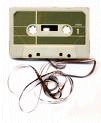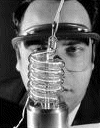| |
The first family planning clinic opened in the UK
The IBM Selectric typewriter utilised reusable magnetic tape
Astroturf, a synthetic material that could be used to replace grass on sports
surfaces, was invented by James M. Faria and Robert T. Wright of Monsanto
Industries
NutraSweet, an artificial sweetener, was invented by Mr. James Schlatter,
at G.D. Searle & Company
Hypertext was invented in the USA for linking electronic text
Frank Partridge invented the portable defibrillator, saving thousands of
lives
Fuzzy logic was invented by Lofti Zadeh at the University of California
Electronic Fuel injection for cars was invented
The International Rice Research Institute in the Philippines released a
semi-dwarf, high-yield Indica variety that, in conjunction with high-yield
wheat, ushered in the Green Revolution
The first hand-held calculator was produced by Texas Instruments for sale
to the public at $2,500 each
The 'breathalyser' was first used on car drivers
The wine box, a plastic bag full of wine contained in a cardboard box, was
invented in Australia
Light pen pens were invented for computers
The computer mouse was invented by Douglas Engelbart
Ralph H. Baer invented the video console
The Russian Tupolev TU-144 became the first supersonic airliner
The 'Trinitron' colour TV tube was developed by Sony
Post codes were launched in London W1
Magnetic-stripe credit cards were introduced
Candido Jacuzzi invented and brought to market the first self-contained,
fully integrated whirlpool bath
Charge Coupled Devices (CCDs) were used to capture images
The mammogram, the first x-ray machines used just for breast imaging, became
available
The
first in-vitro human egg fertilisation was achieved by Patrick Steptoe
and Robert Edwards
The
first automatic analog cellular phone was made in the 1960's
Scientists developed a rocket belt for the US military that was capable
of lifting its wearer nearly 60 feet off the ground
Pratley Putty, Pratley's famous glue, became the only South African invention
that has been to the moon. In 1969 the putty was used to hold bits of
the Apollo XI mission's Eagle landing craft together. Krugersdorp engineer
George Pratley invented his famous sticky stuff in the 1960s while looking
for a glue that would hold components in an electrical box
|
|
Kodak offered the Super 8 format film for home movies
Bausch and Lomb, a company that specializes in eye-contacts, developed soft
contact lenses
The compact optical disk was invented by James Russell
Kevlar was developed at DuPont by Stephanie Kwolek and Roberto Berendt
Owen MacLaren designed the double-joint baby buggy
The first successful dental implants were made
Philips Electric launched the 'Popmaster' portable transistor radio
Fibre Optics were invented in the UK by Charles Keo and George Hockham
The thermal printer was invented by Texas Instruments
The first residential smoke alarm (detector) was designed by Randolph Smith
and Kenneth House of BRK Electronics
The world's first automatic cash dispenser (ATM) opened at Barclays, Enfield
The first Pulsar was discovered by Jocelyn Bell and Antony Hewish
Regular colour television broadcasting began
IBM introduced the floppy disk
The first computer with integrated circuits was manufactured
Robert Dennard invented RAM (random access memory). T.J Watson (owner) and
IBM developed and patented the first memory module called DRAM (Dynamic
Random Access Memory) which became the foundation for short term memory
storage used by computers
Trident Studios introduced 3M 8-track recording decks
The two-tier post system came into operation
The Arpanet (first internet) was developed for use by the US military
Doctor Denton Cooley implanted the first temporary artificial heart
The barcode scanner was invented by Norman Joseph Woodland and Bernard Silver
The PASCAL computer language was developed
Sony introduced its Color Videoplayer (later known as Umatic) which used
a three-quarter inch video cassette tape and had a maximum playing time
of 90 minutes
Christiaan Neethling Barnard, a South African heart surgeon, developed surgical
procedures for organ transplants, invented new heart valves, and performed
the first human heart transplant on Dec. 3, 1967 in a five-hour operation
with a team of 20 surgeons
Bubble Wrap was invented in the USA by Marc A Chavannes
The Respirator, a replacement for the Iron Lung, was developed in the USA
James Black saved millions of lives by inventing Beta Blockers |













